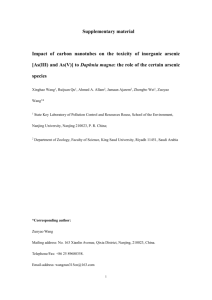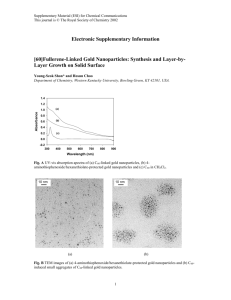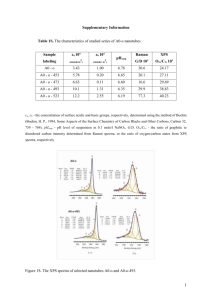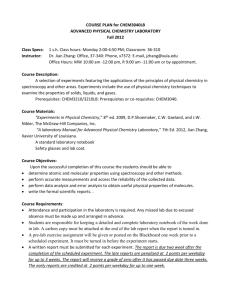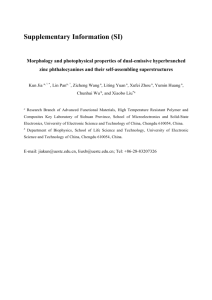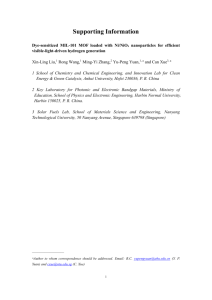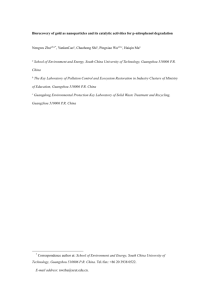Journal of Radioanalytical and Nuclear Chemistry Supplementary
advertisement
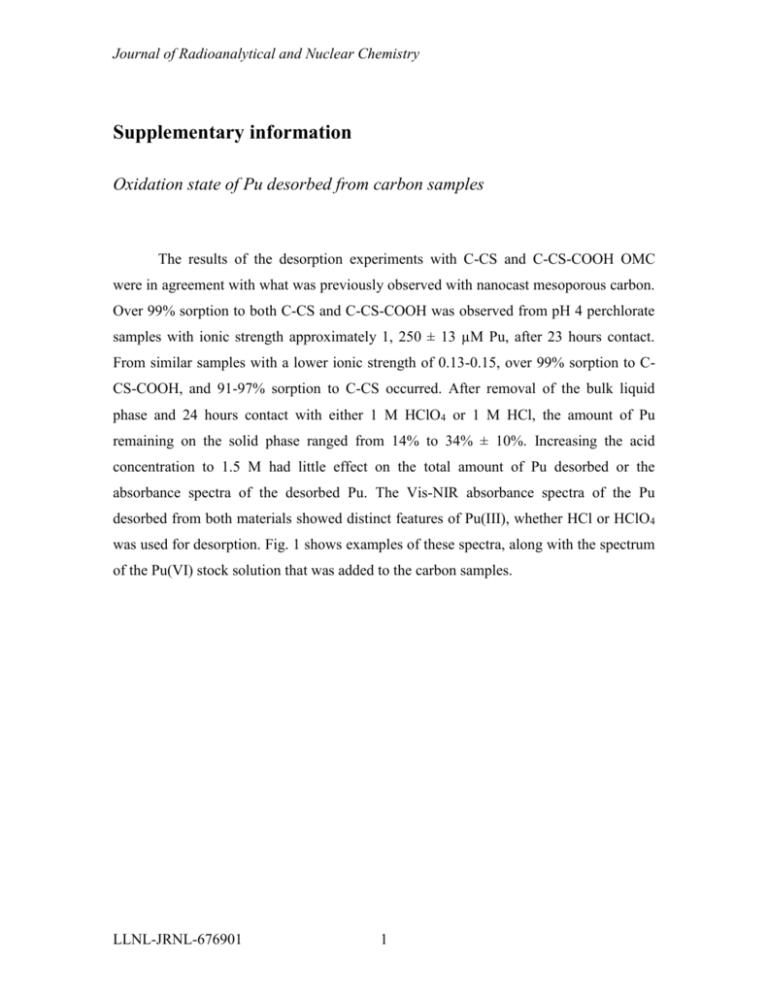
Journal of Radioanalytical and Nuclear Chemistry Supplementary information Oxidation state of Pu desorbed from carbon samples The results of the desorption experiments with C-CS and C-CS-COOH OMC were in agreement with what was previously observed with nanocast mesoporous carbon. Over 99% sorption to both C-CS and C-CS-COOH was observed from pH 4 perchlorate samples with ionic strength approximately 1, 250 ± 13 µM Pu, after 23 hours contact. From similar samples with a lower ionic strength of 0.13-0.15, over 99% sorption to CCS-COOH, and 91-97% sorption to C-CS occurred. After removal of the bulk liquid phase and 24 hours contact with either 1 M HClO4 or 1 M HCl, the amount of Pu remaining on the solid phase ranged from 14% to 34% ± 10%. Increasing the acid concentration to 1.5 M had little effect on the total amount of Pu desorbed or the absorbance spectra of the desorbed Pu. The Vis-NIR absorbance spectra of the Pu desorbed from both materials showed distinct features of Pu(III), whether HCl or HClO4 was used for desorption. Fig. 1 shows examples of these spectra, along with the spectrum of the Pu(VI) stock solution that was added to the carbon samples. LLNL-JRNL-676901 1 Journal of Radioanalytical and Nuclear Chemistry Fig. 1 Visible-NIR absorbance spectrum of Pu stock dilution in 1 M HClO4 (black), and Pu desorbed from C-CS (blue) and C-CS-COOH (red) in 1 M HCl. In the sorption step the carbon samples were contacted for 24 hours with pH 4, 250±13 µM Pu perchlorate solution, in the batch ratio of 1.0 g/L. Although the Pu was added to the samples as Pu(VI), the Pu that desorbed from the samples clearly shows spectral features of Pu(III). Oxidation state changes of 1.25 ± 0.05 mM Pu(VI) in 1.25 ± 0.05 M HClO4, in batch contact with carbons The absorbance spectra of 1.25 ± 0.05 mM Pu(VI) in 1.25 ± 0.05 M HClO4 solution after contact with the SBA-15 is shown in Fig. 2, and is very similar to those of the control soloution (shown in Fig. 1, main text). No redox reaction occurred between Pu and silica, as was expected. Figs. 3-7 show example absorbance spectra of 1.25 ± 0.05 mM Pu(VI) in 1.25 ± 0.05 M HClO4, measured after various lengths of batch contact time with the carbonaceous materials FDU-16, FDU-16-COOH, C-CS-COOH, activated carbon (AC), and graphene nanoplatelet aggregates (GNA), respectively. The majority of Pu(VI) was LLNL-JRNL-676901 2 Journal of Radioanalytical and Nuclear Chemistry reduced to Pu(III) upon contact with the carbon powders, while LSC assays showed that less than 7 ± 10 % of the Pu adsorbed to the carbon in all samples (see Table 1). The contact time required for complete reduction of Pu varies with the specific properties of each carbon powder. Fig. 2 Vis-NIR absorbance spectra taken of 1.25 ± 0.05 mM Pu(VI) solution in 1.2 M HClO4 after contact with SBA-15 mesoporous silica. The introduction of spectral features of Pu(V) and Pu(IV) is similar to what was observed in the control sample due to radiolysis effects. The inset shows the full Pu(VI) peaks at 829.4 ± 1.5 nm, while the main plot is scaled to view the smaller peaks in the spectra. LLNL-JRNL-676901 3 Journal of Radioanalytical and Nuclear Chemistry Fig. 3 Vis-NIR absorbance spectra of 1.25 ± 0.05 mM Pu(VI) solution in 1.2 M HClO4, after contact with FDU-16 mesoporous carbon. Reduction of Pu(VI) began immediately, as evidenced by the approximate 50% decrease in absorbance at 829.4 nm after 51 minutes total contact with FDU-16. The reduction of Pu continued slowly, and after 11 days total contact, only spectral features of Pu(III) were observed. LLNL-JRNL-676901 4 Journal of Radioanalytical and Nuclear Chemistry Fig. 4 Vis-NIR absorbance spectra of 1.25 ± 0.05 mM Pu(VI) solution in 1.2 M HClO4, after contact with FDU-16-COOH oxidized mesoporous carbon. After 52 minutes total contact with FDU-16-COOH, absorbance at 829.4 nm was reduced to approximately 75% of that in the control sample. The reduction of Pu continued slowly, and after 11 days total contact, only spectral features of Pu(III), and to a lesser extent Pu(IV), were observed. LLNL-JRNL-676901 5 Journal of Radioanalytical and Nuclear Chemistry Fig. 5 Vis-NIR absorbance spectra of 1.25 ± 0.05 mM Pu(VI) solution in 1.2 M HClO4, after contact with C-CS-COOH oxidized mesoporous carbon. The majority of the Pu(VI) is reduced to Pu(III) within 23.5 hours total contact. The inset shows the full Pu(VI) peaks at 829.4 ± 1.5 nm, while the main plot is scaled to view the smaller peaks in the spectra. LLNL-JRNL-676901 6 Journal of Radioanalytical and Nuclear Chemistry Fig. 6 Vis-NIR absorbance spectra of 1.25 ± 0.05 mM Pu(VI) solution in 1.3 M HClO4, after contact with amorphous AC. Most of the Pu(VI) is reduced to Pu(III) within the first hour of total contact. LLNL-JRNL-676901 7 Journal of Radioanalytical and Nuclear Chemistry Fig. 7 Vis-NIR absorbance spectra of 1.25 ± 0.05 mM Pu(VI) solution in 1.2 M HClO4, after contact with GNA. Most of the Pu(VI) is reduced to Pu(III) within twenty hours of total contact. The inset shows the full Pu(VI) peaks at 829.4 ± 1.5 nm, while the main plot is scaled to view the smaller peaks in the spectra. Table 1 Average percent sorption of Pu (initially Pu(VI)) in 1.25 ± 0.05 mM Pu, 1.25 ± 0.05 M HClO4 solution, in contact with carbon powders. Percent sorption was determined by LSC counting of the solution phase. % sorption 5 %sorption 29 days Sample days (± 10%) (± 10%) C-CS 0 N/A C-CS-COOH 7 N/A SBA-15 4 6 FDU-16 7 N/A FDU-165 3 COOH AC 3 N/A GNA 3 N/A Oxidation state changes of 1.25 ± 0.05 mM Pu in other acids, in batch contact with C-CS and C-CS-COOH OMCs LLNL-JRNL-676901 8 Journal of Radioanalytical and Nuclear Chemistry Samples of C-CS and C-CS-COOH were prepared with 1.25 ± 0.05 mM Pu in other acidic matrices, to test the versatility of the redox reaction. Table 2 summarizes LSC results from these samples, demonstrating that no significant Pu sorption to C-CS occurred, and small amounts of Pu adsorbed to C-CS-COOH is some of the samples. Table 2 Average percent sorption of Pu (initially Pu(VI)) in 1.25 ± 0.05 mM Pu, solution, in contact with C-CS and C-CS-COOH OMC powders. Percent sorption was determined by LSC counting of the solution phase. % Sorption to CDays % Sorption to C-CSAcid CS contact COOH (± 10%) (± 10%) 1 M HCl/0.3 M 5 1 12 HClO4 1.45 M HCl 5 0 0 1.3 M HNO3 5 1 4 1.3 M HNO3 29 0 10 Figs. 8 and 9 show spectra of a solution of Pu(VI) in 1 M HCl, and 0.3 M HClO4, monitored over time with no solid, and after contact with C-CS, and C-CS-COOH. This solution was prepared by adding Pu(VI) stock solution in concentrated HClO4 to 1 M HCl. The shoulder peak at 836.0 ± 1.5 nm may be attributed to the first Pu(VI) chloride complex, [PuO2Cl]+. Without contact with any solid, the spectrum does not change significantly over the course of 30 days. Within one day of contact with either C-CS or C-CS-COOH, the Pu(VI) in this solution is reduced to Pu(III). LLNL-JRNL-676901 9 Journal of Radioanalytical and Nuclear Chemistry Fig. 8 Vis-NIR absorbance spectra of 1.25 ± 0.05 mM Pu(VI) solution in 1 M HCl, 0.3 M HClO4. The Pu(VI) in solution is stable over the course of 30 days. The inset magnifies the Pu(VI) peaks at 829.4 ± 1.5 nm, with the shoulder at 836.0 ± 1.5 nm, which may be attributed to the first Pu(VI) chloride complex. LLNL-JRNL-676901 10 Journal of Radioanalytical and Nuclear Chemistry Fig. 9 Vis-NIR absorbance spectra of 1.25 ± 0.05 mM Pu(VI) solution in 1 M HCl, 0.3 M HClO4 after contact with C-CS and oxidized C-CS-COOH mesoporous carbons. The majority of Pu(VI) is reduced to Pu(III) within one day of contact with either C-CS or CCS-COOH, with a trace amount of Pu(IV) in the C-CS-COOH sample that is evidenced by the small peak at 471.0 ± 1.5 nm. Spectra of a solution of Pu in 1.45 ± 0.05 M HCl monitored over time with no solid, and after contact with C-CS, and C-CS-COOH are shown in figures 10 and 11. The spectra shown in Fig. 10 indicate that the solution contained a mixture of roughly equal amounts of Pu(III) and Pu(IV), and the features of this spectrum did not change significantly over the course of 30 days. Within one day of contact with C-CS or C-CS-COOH, most of the Pu(IV) in solution was reduced to Pu(III) (Fig. 11). This reduction is easier to achieve than that of Pu(VI), but these results still confirm that the presence of perchloric acid is not necessary in order for Pu to be reduced by carbon surfaces. LLNL-JRNL-676901 11 Journal of Radioanalytical and Nuclear Chemistry Fig. 10 Vis-NIR absorbance spectra of 1.25 ± 0.05 mM Pu solution in 1.45 ± 0.05 M HCl. The Pu in solution is a mixture of Pu(III) and Pu(IV), and the spectral features do not change significantly over the course of 30 days. LLNL-JRNL-676901 12 Journal of Radioanalytical and Nuclear Chemistry Fig. 11 Vis-NIR absorbance spectra of 1.25 ± 0.05 mM Pu(VI) solution in 1.45 ± 0.05 M HCl after contact with C-CS and oxidized C-CS-COOH mesoporous carbons. The majority of Pu(IV) is reduced to Pu(III) within one day of contact with either C-CS or CCS-COOH. Figs. 12, 13 and 14 show spectra of a solution of Pu in 1.3 M HNO3, monitored over time with no solid, and after contact with C-CS, and with C-CS-COOH. The presence of HNO3 slows the reduction of Pu dramatically compared to the HClO4 matrix. Pu redox chemistry is complicated by the reduction of NO3- to NO2-. The relative concentrations of Pu(IV) and Pu(VI) were estimated by assuming those were the only two oxidation states present, and by using the molar extinction coefficients determined for the peaks at 476 nm for Pu(IV) and 831 nm in 1 M HNO3 by Hagan and Miner [1]. In the absence of any solid, the solution is a mixture of approximately 43% Pu(VI) and 57% Pu(IV), and the composition does change significantly over the course of 30 days (Fig. 12). In the presence of C-CS or CS-COOH, the Pu(VI) is slowly reduced over time, and after 29 days contact the Pu(IV) dominates the solution, although a small amount of Pu(VI) remains (approximately 5% in the C-CS sample, and 10% in the C-CS-COOH sample). LLNL-JRNL-676901 13 Journal of Radioanalytical and Nuclear Chemistry The reduction is initially faster when in contact with the C-CS compared to the C-CSCOOH, but after 13 months of contact, approximately 3% of the Pu remained in the hexavalent state in both samples. Fig. 12 Vis-NIR absorbance spectra of 1.25 ± 0.05 mM Pu solution in 1.30 ± 0.05 M HNO3. The solution contains approximately 43% Pu(VI) and 57% Pu(IV), and the spectral features do not change significantly over the course of 30 days. The inset magnifies the Pu(VI) peaks at 829.4 ± 1.5 nm. LLNL-JRNL-676901 14 Journal of Radioanalytical and Nuclear Chemistry Fig. 13 Vis-NIR absorbance spectra of 1.25 ± 0.05 mM Pu solution in 1.30 ± 0.05 M HNO3 after contact with C-CS mesoporous carbon. The Pu(VI) was reduced to Pu(IV) upon contact with the carbon. After one day contact the solution contains approximately 21% Pu(VI) and 79% Pu(IV), and after 29 days contact the Pu(VI) content was reduced to approximately 5%. The inset shows the full Pu(VI) peaks at 829.4 ± 1.5 nm, while the main plot is scaled to display all spectral features. LLNL-JRNL-676901 15 Journal of Radioanalytical and Nuclear Chemistry Fig. 14 Vis-NIR absorbance spectra of 1.25 ± 0.05 mM Pu solution in 1.30 ± 0.05 M HNO3 after contact with oxidized C-CS-COOH mesoporous carbon. The Pu(VI) was reduced to Pu(IV) upon contact with the carbon. The reaction began much more slowly than that with C-CS. After one day contact the solution contains approximately 48% Pu(VI) and 52% Pu(IV), and after 29 days contact the Pu(VI) content was reduced to approximately 10%. The inset shows the full Pu(VI) peaks at 829.4 ± 1.5 nm, while the main plot is scaled to display all spectral features. Dissolution experiments Experiments were performed to test whether the dissolution of Pu(IV) colloids and precipitates by 1 M acids would occur faster in the presence of porous carbon solids. A 1.1 ± 0.1 mM Pu(IV) colloid solution was prepared by drop-wise addition Pu(IV) stock in concentrated HCl to Milli-Q water. A small volume of 10 M NaOH was added to the side of the vial halfway through addition of the Pu stock solution, and quickly mixed in to maintain only slightly acidic conditions, without precipitation. The solution pH rose to 1.9 during 6 days of gentle rocking, then remained constant until the colloidal solution was partitioned for batch and column experiments, a total of 11 days after preparation. The absorbance spectrum showed the characteristic broad peak at 613 nm, and was LLNL-JRNL-676901 16 Journal of Radioanalytical and Nuclear Chemistry unaltered by centrifugation for 10 minutes at 7000 RPM. In the control sample, a small volume of concentrated HClO4 was added to the colloidal solution to give a total acidity of 1.0 ± 0.1 M, and the absorbance spectrum of the solution was measured after various lengths of time, both in a control sample with no solid, and in batch contact samples with 200 ± 10 mL/g C-CS and AC powders. Another 1.00 ± 05 mL aliquot of the colloid solution was acidified and immediately pushed through a glass column packed with 40 ± 4 mg AC particles (~3 cm × 2.5 mm diameter) with argon gas at an approximate rate of 25 min/mL. The absorbance spectra and LSC analysis of colloidal solution, measured at various lengths of time after HClO4 was added showed features of both aqueous and colloidal Pu(IV) after 15 hours but only aqueous Pu(IV) after 87 hours (see Fig. 15). LSC measurements indicated 7 ± 10 and 28 ± 10 percent Pu missing from the solution phase at 15 h and 87 h, respectively. It is not clear whether this is due to Pu(IV) adsorption to the polypropylene vial, or colloidal particles that aggregated into larger particles and were centrifuged out of solution. In batch samples of acidified colloidal solution with C-CS (Fig. 16) and AC, colloidal Pu(IV) particles seemed to adsorb or aggregate to carbon particles, but dissolved completely to aqueous Pu(III) within the 87 hours. After 15 hours contact with C-CS or activated carbon, only spectral features of Pu(III) were observed in the absorbance spectra of the solutions, but LSC measurements indicated 15 ± 10 and 38 ± 10 percent of the Pu was still sorbed to C-CS and AC, respectively. After 87-88 hours of contact, only 4 ± 10 percent of the Pu was missing from solution phase in the carbon samples, indicating near complete dissolution to Pu(III) occurred. LLNL-JRNL-676901 17 Journal of Radioanalytical and Nuclear Chemistry Fig. 11 Vis-NIR absorbance spectra of the colloidal Pu solution before and after addition of concentrated HClO4 to give a 1.0 ± 0.1 M HClO4 solution. As the colloidal Pu(IV) slowly dissolved into aqueous Pu(IV) , the broad peak at 615 nm disappeared, absorbance of light around 650 nm increases, and the sharp peak at 472.6 ± 1.5 nm appears. LLNL-JRNL-676901 18 Journal of Radioanalytical and Nuclear Chemistry Fig. 12 Vis-NIR absorbance spectra of the colloidal Pu solution after addition of concentrated HClO4 to give a 1.0 ± 0.1 M HClO4 solution, in batch contact with C-CS mesoporous carbon powder. In the presence of C-CS, the Pu colloids dissolve into aqueous Pu(III). The AC column test showed that a porous carbon column may be used to partially dissolve Pu(IV) colloids in 1 M acid on a much shorter timescale. LSC analysis of the eluted solution showed that it contained 67 ± 7 % of the Pu that was loaded, and the absorbance spectrum (Fig. 17) showed features consistent with aqueous Pu(III). It is particularly interesting that the undissolved portion of Pu(IV) colloid appears to have remained on the column, thereby separating it from the Pu solution. The effects of Pu colloid particle size and carbon pore size on the adsorption and reductive dissolution of Pu colloids is an interesting area for future studies. LLNL-JRNL-676901 19 Journal of Radioanalytical and Nuclear Chemistry Fig. 13 Vis-NIR absorbance spectra of a colloidal Pu solution before and after addition of concentrated HClO4 to give a 1.0 M HClO4 solution, and after being eluted from a column packed with activated carbon in 1 M HClO4. The AC column partially dissolved and reduced the Pu colloids to aqueous Pu(III). A 1.5 ± 0.1 mM Pu colloid solution with pH 2.04 was prepared as described above, and rocked gently for 9.3 weeks before it was used for the dissolution/reduction experiment. The Pu particles had grown or aggregated, such that 81 ± 4 % of the Pu was removed from the solution by centrifuging 10 minutes at 7000 rpm, with a green precipitate visible at the bottom of the conical vial after centrifugation. The particulates were evenly distributed into a slurry by shaking the sample before portions were removed and acidified to 1.09 ± 0.01 M HCl to test the dissolution of a control sample, and one in contact with activated carbon (200 ± 10 mL/g). The concentration of Pu in the solution phase of each sample after various lengths of time was determined via LSC, following centrifugation of the samples for 10 minutes at 7000 rpm. The same experiment was performed with C-CS and C-CS-COOH after the precipitate aged a total of 14 weeks. LLNL-JRNL-676901 20 Journal of Radioanalytical and Nuclear Chemistry Fig. 18 plots the Pu concentration measured in the samples described above, and shows the carbon containing samples initially have less plutonium in the solution phase than the acidified control samples. This likely occurs because as the particles dissolve to become smaller, they remain in colloidal suspension in the control samples, but adsorb or aggregate with the carbon particles. This is particularly evident with the C-CS-COOH sample, where the high concentration of functional groups promotes adsorption of Pu, even in acidic solutions. However, it appears that the reduction of Pu by the carbon promotes faster dissolution of the Pu precipitates in the long run, especially the unoxidized activated carbon and C-CS mesoporous carbon. Example absorbance spectra measured of the supernatant after various lengths of dissolution time are shown with HCl only (Fig. 19) and in the presence of C-CS (Fig. 20). These spectra confirmed that reductive dissolution took place for all of the carbon samples. In 1.09 ± 0.01 M HCl alone the precipitates only partially dissolved within the experimental timeframe, into primarily aqueous Pu(IV). In the presence of activated carbon and C-CS the precipitate dissolved completely into aqueous Pu(III). The oxidized C-CS-COOH also reduced the Pu to Pu(III) as it dissolved, but in that sample some of the Pu remained associated with the solid phase. LLNL-JRNL-676901 21 Journal of Radioanalytical and Nuclear Chemistry Fig. 14 Concentration of soluble Pu in mM vs. hours following acidification of Pu(IV) precipitate slurries with 1. 09 ± 0.01 M HCl only (Control 1 and 2, hollow and black squares) or in batch contact with AC (green circles) C-CS (blue triangles) and C-CSCOOH (red diamonds) carbon powders. LLNL-JRNL-676901 22 Journal of Radioanalytical and Nuclear Chemistry Fig. 15 Vis-NIR absorbance spectra measured in the supernatant from centrifugation of a 1. 09 ± 0.01 M HCl solution containing a Pu precipitate (aged 14 weeks in pH 2 solution before HCl was added), after different lengths of time since HCl addition. The data shows that the precipitate dissolved primarily to aqueous Pu(IV), with traces of higher oxidation states. LLNL-JRNL-676901 23 Journal of Radioanalytical and Nuclear Chemistry Fig. 6 Vis-NIR absorbance spectra measured in the supernatant from centrifugation of a 1. 09 ± 0.01 M HCl solution containing a Pu precipitate (aged 14 weeks in pH 2 solution before HCl was added), after different lengths of time since addition of HCl and C-CS OMC. The data shows that the precipitate dissolved primarily to aqueous Pu(III). Column Experiments Approximately 30 mg of activated carbon or C-CS was packed into a glass column (2 cm x 2.5 mm) as a slurry in 1 M HClO4, and solutions of Pu (1.25 ± 0.05 M HClO4 and 1.20 ± 0.1 mM Pu(VI)) were reduced by passing through the columns. Fig. 21 shows the Vis-NIR absorbance spectra of the solution both before and after passing through the AC column, and clearly illustrates that Pu(VI) was reduced to Pu(III) by passing through the column of AC particles. Fig. 22 shows results from a similar experiment with a column of C-CS particles. No preconditioning or changes of solution matrix were necessary. The average elution rate was ~10 seconds per drop, which required pressure in the AC column, but not the C-CS column, corresponding to approximately 15 minutes per 1 mL aliquot of Pu (VI) solution reduced. Thus, it was LLNL-JRNL-676901 24 Journal of Radioanalytical and Nuclear Chemistry demonstrated that a column packed with mesoporous carbon is a convenient way to reduce oxidized Pu to Pu(III) in acidic solutions. Fig. 21 Vis-NIR absorbance spectra of a 1.25 ± 0.05 mM Pu in 1.25 ± 0.05 M HClO4 solution both before and after passing through a glass column packed with activated carbon particles (2 cm x 2.5 mm). The Pu(VI) was quickly reduced to Pu(III) by passing through the column. LLNL-JRNL-676901 25 Journal of Radioanalytical and Nuclear Chemistry Fig. 22 Vis-NIR absorbance spectra of a 1.25 ± 0.05 mM Pu in 1.25 ± 0.05 M HClO4 solution both before and after passing through a glass column packed with C-CS mesoporous carbon particles (2 cm x 2.5 mm). The Pu(VI) was quickly reduced to Pu(III) by passing through the column. LLNL-JRNL-676901 26 Journal of Radioanalytical and Nuclear Chemistry a b LLNL-JRNL-676901 27 Journal of Radioanalytical and Nuclear Chemistry Fig. 23 Example visible absorbance spectra measured from 1.0 ± 0.2 mL fractions of 1.28 ± 0.06 mM Pu in 1.13 ± 0.05 M HClO4, initially Pu(VI), eluted from a 2.5 mm diameter glass column containing 33 ± 1 mg activated carbon powder. The Pu(VI) in the first 1 mL (F2) Pu solution to pass through the column was reduced completely to Pu(III), and subsequent fractions were partially reduced. Evidence of Pu(V) eluting from the column is observed for F3-17 (Fig. 23a), while the Pu(VI) peak is only significant after 6 mL eluted (F7-17, Fig. 23b). To put constraints on the overall capacity of the carbons for the Pu(VI) to Pu(III) reduction, batch samples of activated carbon and OMC spheres were prepared with 1.25 ± 0.05 mM Pu(VI) in 1.25 ± 0.05 M HClO4, and liquid-to-solid ratios of 374 ± 10 mL/g or 750 ± 20 mL/g, and one week total contact time. These samples contained 0.47 ± 0.02 and 0.94 ± 0.05 mmol Pu per g carbon, and the absorbance spectra of their supernatants are shown in Fig. 24. These tests showed that the OMC spheres have a larger capacity to reduce Pu(VI) to Pu(III) than the AC, as the solution with 0.94 mmol/g of OMCS is completely reduced to Pu(III), while that in contact with AC is a mixture of Pu(III) and Pu(IV). LLNL-JRNL-676901 28 Journal of Radioanalytical and Nuclear Chemistry Fig. 24 Absorbance spectra of initially 1.25 ± 0.05 mM Pu(VI) in 1.25 ± 0.05 M HClO4 solutions after one week of batch contact with AC and OMCS in the ratio of 0.47 ± 0.02 and 0.94 ± 0.05 mmol Pu per g carbon. The solutions in contact with OMCS reduced completely to Pu(III) while samples with 0.94 ± 0.05 mmol Pu per g activated carbon were reduced to a mixture of Pu(III) and Pu(IV). Supplementary References 1. Hagan P G, Miner F J (1969) Spectrophotometric determination of plutonium III, IV, and VI in nitric acid solutions. Report prepared for U.S. Atomic Energy Commission, RFP-1391, UC-4 Chemistry, TID-4500-54th Ed. LLNL-JRNL-676901 29
